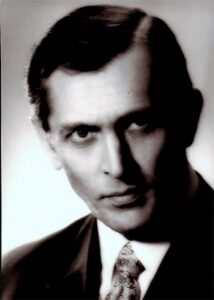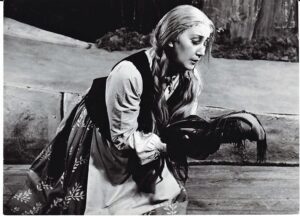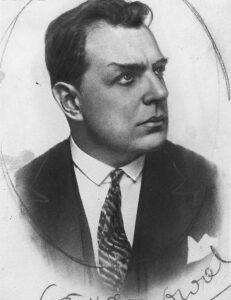I am happy to announce that the 3CD release of carefully remastered recordings of Moniuszko’s music – the part of the series Heritage under the label of Anaklasis, launched by PWM Editions – has been just published. This album is absolutely crucial to proper recognition of his oeuvre and worth every single penny. Stay at home and go to the PWM’s online shop: https://pwm.com.pl/en/sklep/publikacja/songs–arias–ouvertures,stanislaw-moniuszko,22188,ksiegarnia.htm. Instead of a teaser, I post my text from the box’ booklet, where I also give some information about the artists involved. Enjoy!
***
The Vistula-Oder Offensive, mounted by the forces of the 1st Belorussian Front, which also included Polish troops, the 1st Ukrainian Front, and two armies of the Polish Armed Forces in the East, still continued. From 15th January 1945, the advancing forces captured successively such cities as Kielce, Częstochowa, Radom, Warsaw, and Krakow. On the memorable Saturday of 27th January, the Soviet armies liberated the Nazi complex of concentration camps in Auschwitz-Birkenau. Three days earlier, the Red Army made an attempt to encircle Festung Posen (the Poznań Fortress), which was one of the first manoeuvres in the murderous battle for the capital of Greater Poland. The war would last for over three months more.
In the meantime, in the streets of Łódź, which was liberated on 17th January, there immediately appeared handwritten notices about recruitment of musicians for a symphony orchestra. The city emerged nearly intact from the ravages of war. The waterworks functioned normally, the power station supplied electricity. Musicians frantically collected sheet music, tuned their instruments, and assembled makeshift music stands. The orchestra, created nearly from scratch, found shelter at the Powszechny Theatre. Zdzisław Górzyński was appointed head of the Municipal Philharmonic early in February. The Łódź audience knew him from the pre-war period, when the conductors at Łódź Philharmonic included Emil Młynarski, Walerian Bierdiajew, and Grzegorz Fitelberg. At the inaugural concert, the concert master was Bronisława Rotsztat, who miraculously survived from the last transport to Auschwitz. Music life came back to Łódź on 15th June 1945, with the very first measures of ‘Fairy Tale’ Fantastical Overture.
Moniuszko’s music, along with Chopin’s immortal works, was included in the repertoires of all the orchestras revived after the war. Nearly every theatre that was resuscitated or organised anew began its first season with a premiere of Halka or The Haunted Manor. Moniuszko choirs sprang up like mushrooms, even in such improbable places [small towns and villages – translator’s note] as Krapkowice, Mazańcowice, and Czerwionka in Silesia, Bolewice and Plewiska in Greater Poland, Radawnica and Jeżewo in Pomerania. An anonymous journalist reported in June 1948 in “The Voice of Pabianice” that “Moniuszko’s music delights, moves and enchants. Despite its beauty and charm, it is extremely sincere, fresh, simple, and full of feeling. Moniuszko is the singer of the nation’s very soul. He derives his inspiration from the songs and art of the people, which are his source and model. This is why Moniuszko’s music is close to our hearts and dear to us all, because it touches us so, penetrates deep, and dazzles us.”
Moniuszko always stayed a bit on the sidelines. He was an ingenuous man who did not flaunt his political views, and did not feel well in the world of the rich and famous. His music circulated in the form of loose sheets or copies because he himself either did not want to or was unable to put his output in order. He was also not always capable of reaching an agreement with potential publishers. This may be why for many long years he gained more popular-public than critical and musicological acclaim. Possibly for the same reason, he was an easy tool for all kinds of propaganda systems. Following World War I, his music nicely fitted in with the Polish pro-independence rhetoric, whereas after the next war it fell victim to the ideologists of the communist ‘People’s Poland’. As late as in the 1970s, the operatic education of young Poles still began with a ‘trip’ to the theatre to see Halka, and every child knew at least The Distaff and the ‘bachelor vows’ from The Haunted Manor, if not any other pieces. They were reprinted year after year in the course books for obligatory music lessons in primary schools, and conscientiously drummed into the heads of Year Four pupils, regardless of their individual musical predispositions.
Some found this situation uncomfortable but in a way natural. The ‘familiar’ phrases of Moniuszko’s songs and arias are easier to memorise than virtuosic passages from Chopin’s Études. Excerpts from Moniuszko’s most popular operatic libretti functioned in everyday talk as ‘wingéd words’ quoted out of context, while the poems of well-known authors, analysed in class, were inextricably linked with the tunes of his I-must-have-heard-it-somewhere songs. This was largely owing to the choral societies, founded already in the 19th century. But of much greater importance to the popularisation of Moniuszko’s oeuvre was the music record industry.
Andrzej Hiolski. Photo: Grand Theatre, Warsaw, Archive Unit
Thousands of private record collections perished in the war, most of all – the productions of the famous label Syrena-Elektro, but also of the Polish branches of His Master’s Voice, Columbia, and Parlophone. Recordings of Halka as interpreted by Helena Zboińska-Ruszkowska with the orchestra of Warsaw Opera under Artur Rodziński were no longer so easy to access, and in the ruined cities, now undergoing reconstruction, one could no longer hear Eugeniusz Mossakowski singing The Evening Song from a vinyl record. The recordings of overtures and orchestral fragments under the baton of Józef Ozimiński and Bronisław Szulc were likewise quite forgotten. The process of catalogue building had to start from scratch, in the complex circumstances of record companies being nationalised, private ones closing down, as well as artistic decisions being frequently politically motivated and imposed by the state authorities. The present 3CD anthology consists of recordings from the years 1951-1961, the oldest of which were made by ‘Muza’ United Music Industry Factory in Warsaw, while the later ones, after 1956, were already released under the label of ‘Polskie Nagrania’ Public Company. These recordings are documents – fascinating in many respects – of an age of transition, when the old performance schools were gradually disappearing, and a new aesthetic was already in the making, represented by the then young singers and conductors. Some of them later chose quite different career paths, but the interpretations of several of them are part of the strict canon of postwar Moniuszko interpretations.
Józef Ignacy Kraszewski wrote about Moniuszko’s songs in 1844, directly after the publication of the First Songbook for Home Use: “Should everyone in our country come to recognise Mr Moniuszko’s talent, we would no longer envy the Germans for the ditties written by Schubert and Mendelssohn-Bartholdy (…). May the beautiful ladies (…) take pity and prove their taste by welcoming Mr Moniuszko’s songbook and placing it in the company of the said foreign masters, whose only superiority to Mr Moniuszko lies in the fact that they were lucky enough to be born and gain their fame abroad, not here.”
We often take for granted the widespread opinion that the Songbooks were a kind of educational almanacs, and that the songs they contain were meant to be, first and foremost, melodious and ear-catching, while the accompaniment was unsophisticated and the harmonies – plain. That we brush Moniuszko’s songs off is also the composer’s own fault. In the advertisement for the first book, published in the “Petersburg Weekly”, he claimed that “even poorer music, which proves less felicitously made, can be excused if the poetry is excellent.” And yet, in the twelve Songbooks, most of which were published posthumously, one may find not only short strophic songs, but also compositions written with experienced, technically competent singers in mind, in which the text is of overriding importance, the accompaniment calls for a rich piano technique, and the musical language demonstrates strongly individual qualities.
The six songs performed by Maria Kunińska-Opacka and Jerzy Lefeld are relatively late pieces selected from books VIII and IX of the Songbooks, only published as late as 1908 by the Warsaw Music Society (WTM). Nearly each of these miniatures has an interesting story behind it. Song to the Sun is a setting of a poem by Wacław Szymanowski based on motifs from Casimir Delavigne’s tragedy Paria, the same one which also provided the basis for Moniuszko’s opera to a libretto by Jan Chęciński. The text of The Four Seasons was penned by Miron (pen name of Aleksander Michaux), an eminent but sadly forgotten Parnassian poet. Antoni Kolankowski, author of Little Flower, was an acclaimed translator, of, among others, Lermontov’s verse play Masquerade. Rue, to words by the Polish exile Jan Prusinowski, was composed for the outstanding baritone Jan Koehler, soloist of Warsaw Opera and the first performer of the part of Maciej in The Haunted Manor. The text of The Return of Spring comes from the Polish ‘Oriental’ writer Gustaw Zieliński, a representative of the Ukrainian school in the Polish Romanticism, whereas Ophelia’s Song is nothing else but excerpts from Shakespeare’s Hamlet, as translated by Krystyn Ostrowski. Kunińska-Opacka, the excellent performer of these song, boasted a dark, perfectly trained spinto lyric soprano, as well as an intelligent manner of interpretation, supported here by the musical experience of Lefeld, one of 20th-century Poland’s most eminent chamber musicians and accompanist. These performances represent a dazzling musical culture and great musicality, which comes as no surprise if we remember that the singer was also a very well educated and eminently gifted violinist.
Andrzej Hiolski’s nasal and slightly ‘smoky’ baritone is one of the most beautiful and recognisable voices in the history of Polish vocalism. He is accompanied here by Sergiusz Nadgryzowski – Lefeld’s contemporary, a pre-war Warsaw Opera répétiteur and collaborator of the underground Opera Studio under the German occupation; later a pianist at Warsaw Philharmonic and accompanist of the Teatr Wielki soloists in Warsaw. The songs Hiolski performs on this CD come from different periods of Moniuszko’s work. Similarly to Kunińska-Opacka, Hiolski impresses the audience with elegant phrasing and apt interpretations of the texts, which include jewels by first-class poets. Soldier’s Song from Book II of the Songbooks comes from the play Beautiful Woman by Józef Korzeniowski, an eminent Polish Romantic playwright. Do You Know the Land from Book IV sets Adam Mickiewicz’s translation of Goethe’s poem from his didactic novel Wilhelm Meister’s Apprenticeship. O Mother Mine from Book V was penned by Jan Prusinowski; Two Dawns from Book XI is a setting of Teofil Lenartowicz’s poem from the collection The New Little Lyre, published in 1859.
Antonina Kawecka as Halka. Photo: Grand Theatre, Poznań, Archive Unit
The programme of the second CD consists of arias and ensemble scenes from legendary recordings of operas: The Raftsman, Halka, and The Haunted Manor. The performance of The Raftsman – featuring the phenomenal Halina Słonicka (soprano) as Zosia, the golden-voiced tenor Bogdan Paprocki (Franek), and the Warsaw Philharmonic ensembles under the baton of the same Zdzisław Górzyński who took up the direction of Łódź Municipal Philharmonic in February 1945 – can still be considered as in many respects a model interpretation. Most of the excerpts from Halka are selections from a Poznań production of this opera, recorded in 1953 without audience participation. The cast includes the then best singers performing on that stage. Antonina Kawecka, with her dense, dark dramatic soprano, demonstrating a wide volume range, is equally convincing as the hapless highland girl Halka as she was in the complex and technically extremely demanding part of Wagner’s Isolde. Wacław Domieniecki (Jontek), one of the few genuine heroic tenors in postwar Poland, makes a great impression especially with his ease in the top range. Marian Woźniczko (Janusz) captivates the audience with his warm and velvety-soft, wonderfully tinged baritone. The whole is conducted by a pupil of Arthur Nikisch, Walerian Bierdiajew, who gained fame with his immense repertoire and excellent collaboration with the singers-soloists. His Halka juxtaposes lyrical passages with a nearly Wagnerian dramatism, which is constantly present. What makes this grand interpretation successful is largely the perfect choice of soloists.
An interesting complement to this Poznań production is Jontek’s aria from Act IV, recorded eight years later under Jerzy Semkow. Bogdan Paprocki’s interpretation of this role is very different from that of Domieniecki; Paprocki’s Jontek is not merely desperate, but humiliated and helplessly furious.
The Poznań recording of The Haunted Manor was made a year later than that of Halka, also under Bierdiajew and in similar circumstances. Woźniczko as the Sword-Bearer gives a display of the kontuszowy style (representing the Polish nobility), which the older generation unequivocally associates with Moniuszko’s operatic language. The conductor again selected strong, distinctive and expressive voices with excellent breath support. We will enjoy the sonorous, metallic soprano of Barbara Kostrzewska (Hanna), at ease both in the coloraturas and the wide cantilenas; Felicja Kurowiak’s (Jadwiga) dense and warm mezzo, and the full, incredible noble bass voice of Edmund Kossowski (Zbigniew), who would soon afterwards make his mark in Warsaw as Boris in Mussorgsky’s opera. It is the more interesting to compare Kossowski’s voice with the more ‘jovial’ sound of his famous rival Bernard Ładysz, who in 1960 recorded Skołuba’s aria from Act III under Jerzy Semkow. In the splendid aria, or rather a dramatic scene with carillon, we will again hear Bogdan Paprocki, who sang Stefan more than 250 times on the stage and is still considered today as the most convincing interpreter of that role in all the postwar stage history of The Haunted Manor.
Walerian Bierdiajew in 1934. Photo: NAC
Moniuszko’s overtures – one of which, ‘Fairy Tale’ Fantastical Overture, attracting the ear with lively narration, skilful orchestration, and a wealth of expressive contrasts, was conceived as an autonomous composition – have for decades lived their own independent life as concert pieces. Following the premiere of The Raftsman, the reviewer of “News Chronicle” grumbled about Moniuszko “giving us this material [suitable] for a much larger-scale opera, in which the very overture proves that he found it hard to squeeze his music into the one-act form imposed by the librettist.” Whatever the case, this extensive and atmospheric introduction, which develops after a while into a suggestive storm scene, comprises an entire story, which only an orchestra under the baton of a true master can well represent. The overture to Verbum nobile, on the other hand, sparkles with joyful virtuosity, while that for Paria carries the audience away with its wild drama. The Countess opens with a hearty mazur, contrasted with an elegant salon waltz. The Halka overture, in classical sonata form, summarises not so much the action, as the idea of this stage work. The one for The Haunted Manor brings to mind Rossini’s light and virtuosic overtures. As in the case of the other CDs in our collection, the listeners may compare and judge for themselves what suits them best, in this case – among the interpretations of Moniuszko’s orchestral music. Will it be Fitelberg’s characteristic textural sense and the ability to emphasise coloristic qualities? Or the combination of ‘Russian-type’ lyricism with ‘German-type’ care for good construction, typical of Bierdiajew? Or perhaps it will be Krenz’s clockwork precision in every polished detail, which enhances the emotions contained in the music?
Whether Moniuszko was truly a singer of the nation’s soul – is not for me to judge. All I can say is that he touches, penetrates, and dazzles, especially in these old interpretations, which can well become a vast source of inspiration for contemporary performers.
Translated by: Tomasz Zymer



